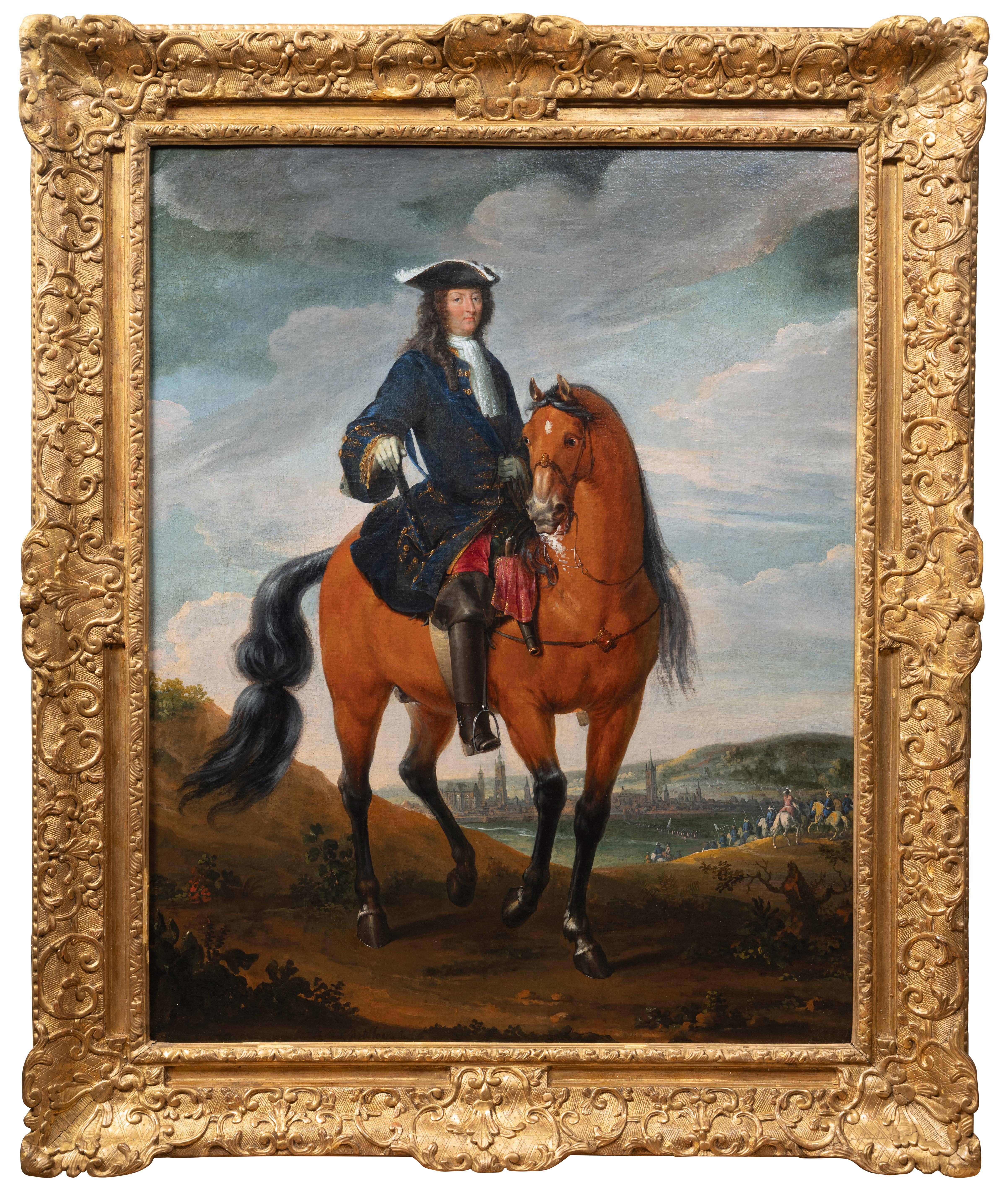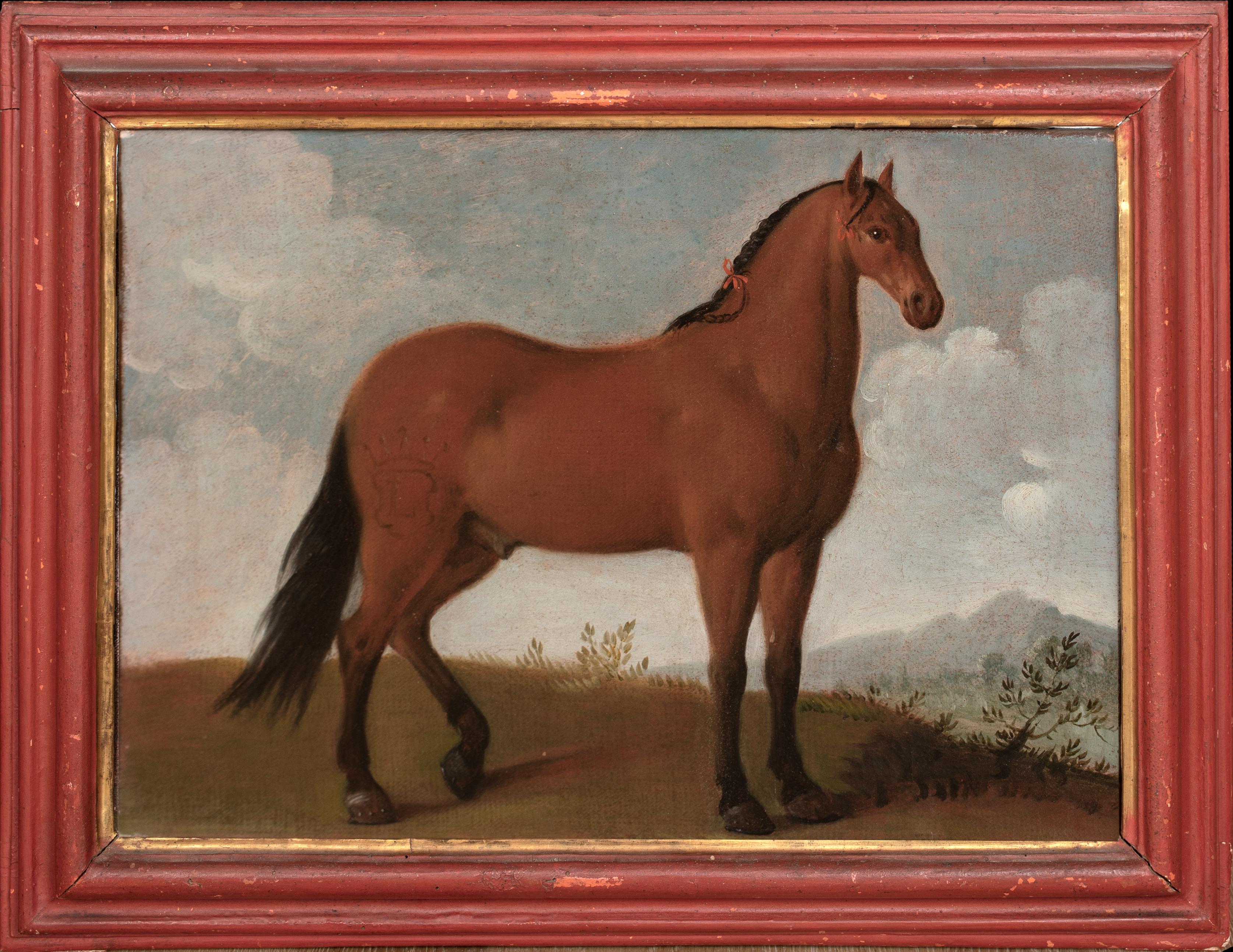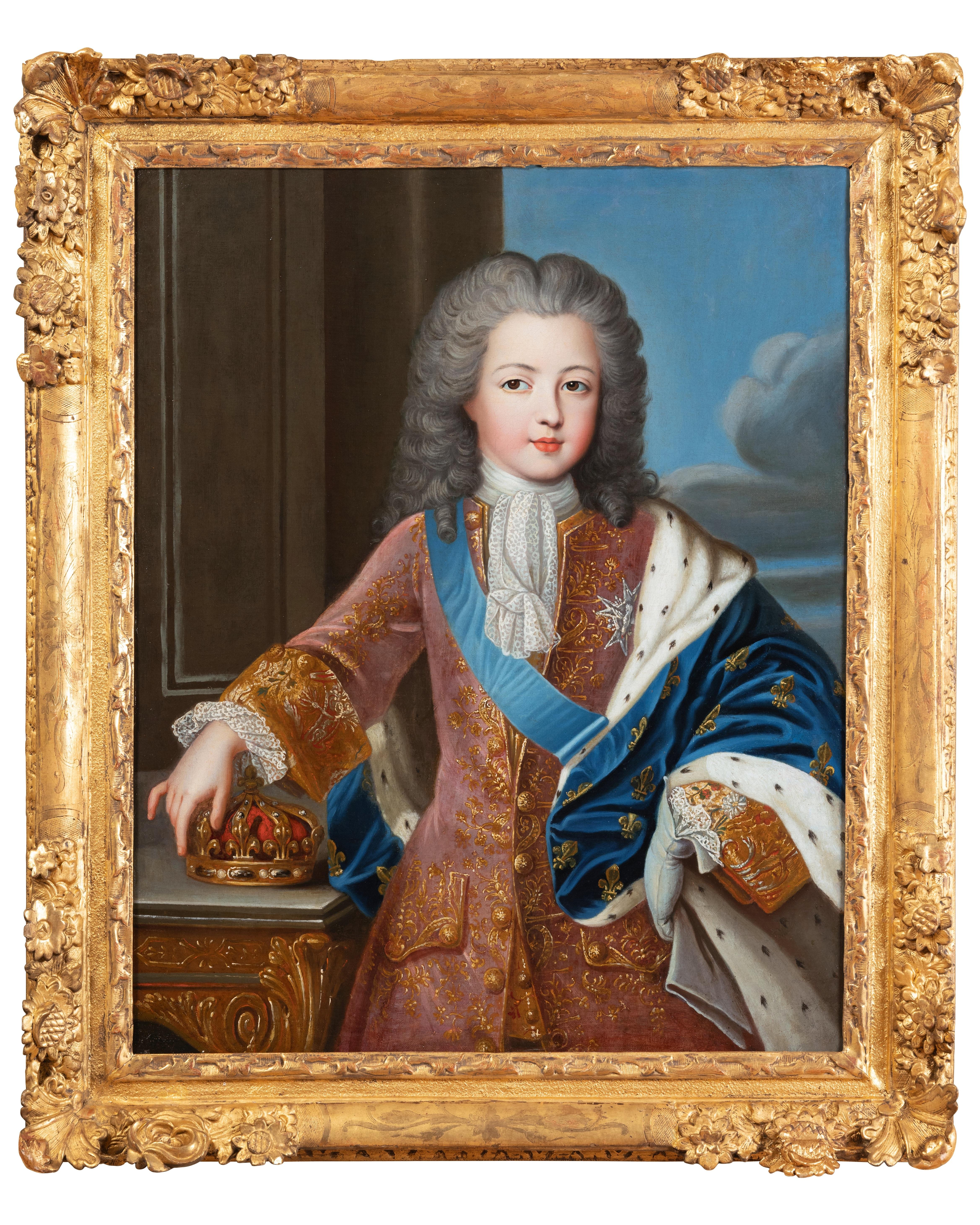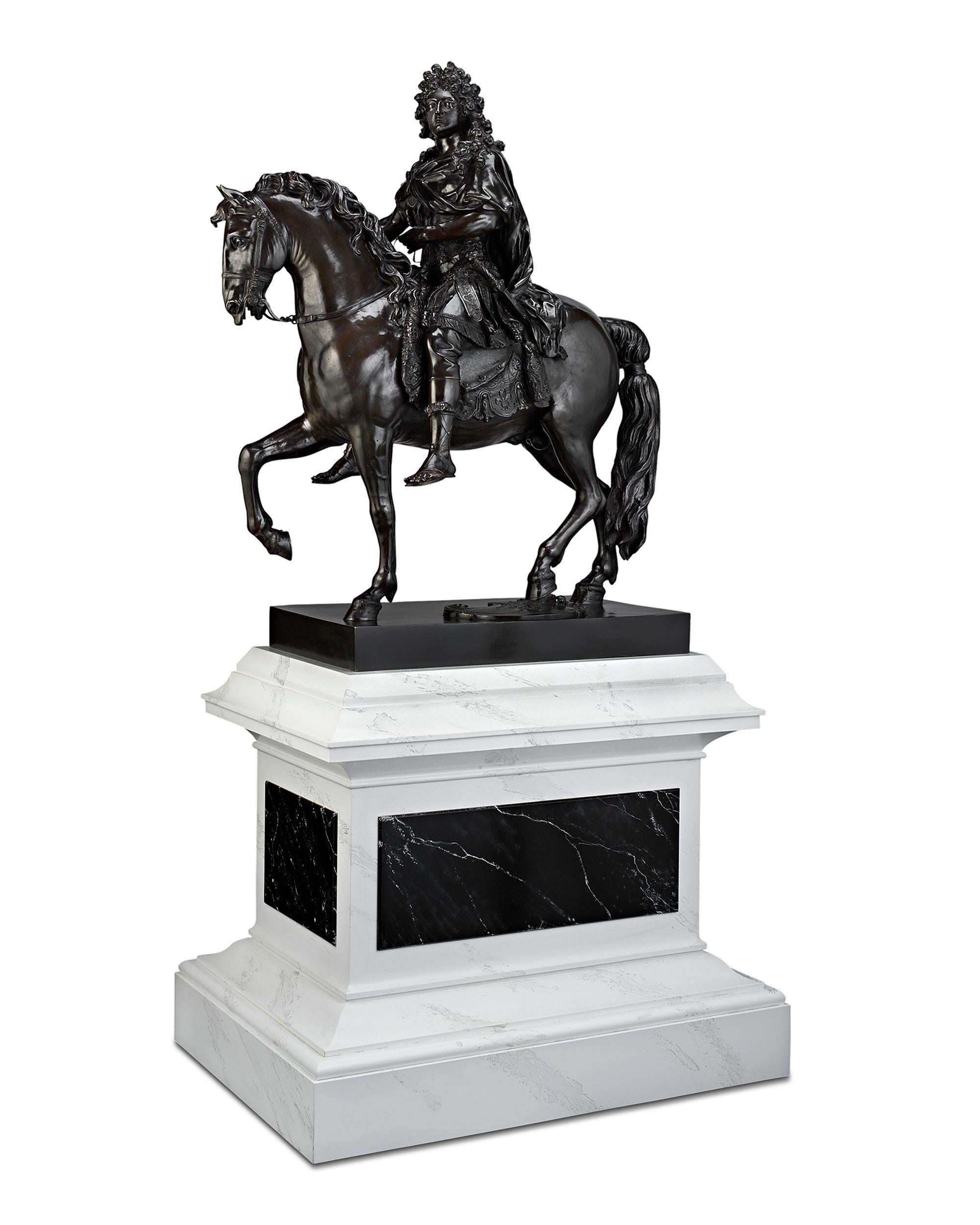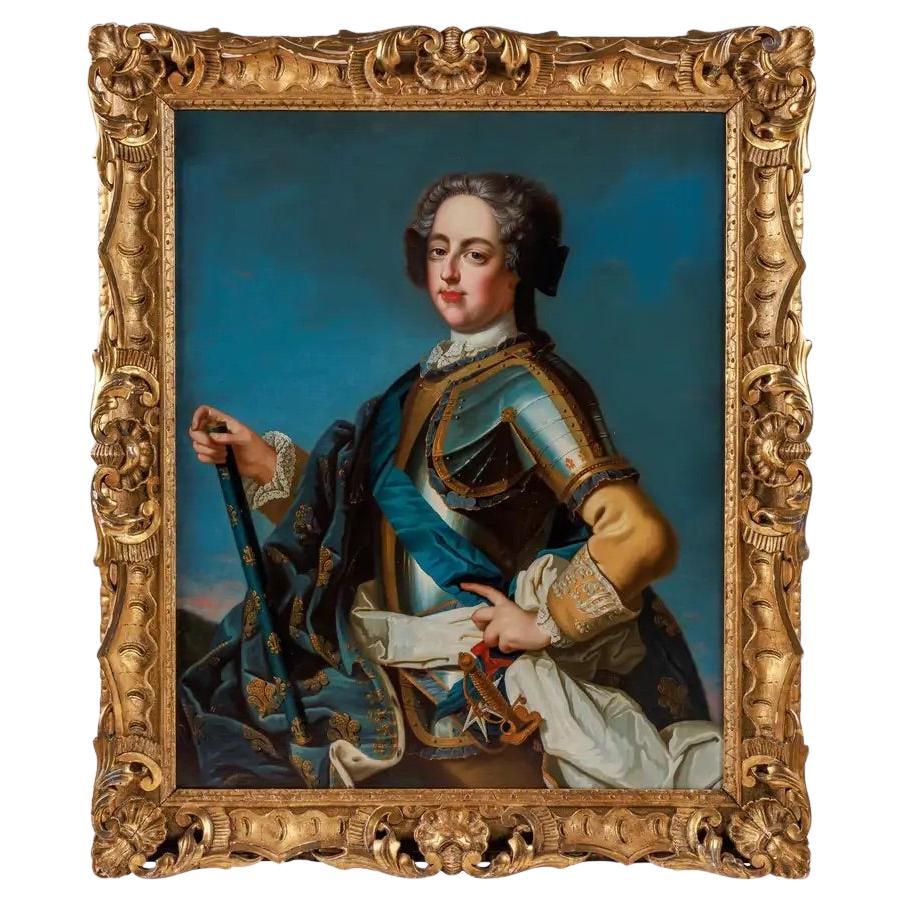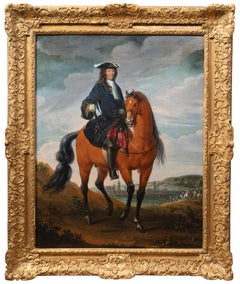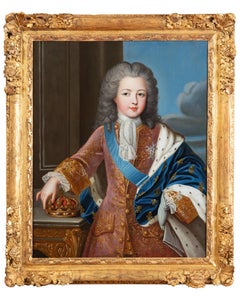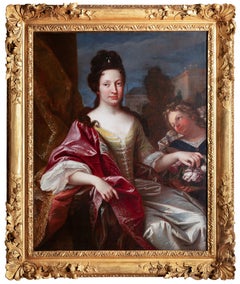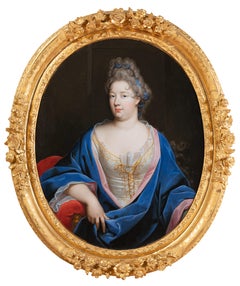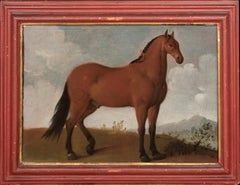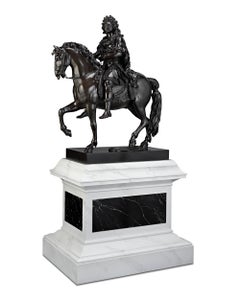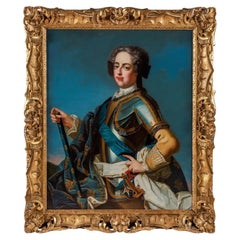Items Similar to Equestrian portrait of Louis XIV, workshop of René-Antoine Houasse, c. 1690
Video Loading
Want more images or videos?
Request additional images or videos from the seller
1 of 13
Equestrian portrait of Louis XIV, workshop of René-Antoine Houasse, c. 1690circa 1690
circa 1690
$33,132.75
£24,992.30
€28,000
CA$46,491.05
A$50,697.65
CHF 26,632.80
MX$607,641.75
NOK 337,730.08
SEK 314,289.65
DKK 213,311.79
About the Item
Equestrian portrait of Louis XIV,
Workshop of René-Antoine Houasse, (Paris, c. 1645 - Paris, 1710)
Late 17th century French school, c. 1690
Oil on canvas, h. 100 cm, w. 80 cm
Important 17th century giltwood frame richly carved with flowers and foliage.
Framed: h .128 cm, w. 108 cm
Our ceremonial equestrian portrait represents the king aged around thirty. Louis XIV appears in it as an army leader, dominating a battle scene in the background. He holds the baton of command, a sign of his authority, and is mounted on a white horse called "soup de lait", rearing, a symbol of victory. The king is sumptuously dressed in a jerkin embroidered with gold thread, a black hat with a white plume, and a lace tie. His sword, stirrups and horse harness are decorated with precious stones and diamonds, testifying to the wealth and power of the rider. His black boots with red soles and heels are adorned with gold spurs.
The horse is there to enhance the power and grandeur of the rider, depicted as a conquering king, who is also painted on a slightly larger scale than the horse in order to emphasize his majesty.
Our work is a reduced-format version of the painting by Réné-Antoine Houasse and kept at the Arras Museum (h. 280 cm, 230 cm).
In 1674 Charles le Brun received the commission for a portrait of Louis XIV on horseback in front of a battlefield. Le Brun provided a drawing and Houasse produced the full-size cardboard kept in the Department of Graphic Arts at the Louvre Museum. We know that five versions of the large painting are documented in the inventory of the Garde-Meuble. The most famous is the one exhibited at the Salon de Mars in Versailles. (h. 255 cm, l. 200 cm). Other large formats are in Perpignan, Besançon, at the Château de Vaux-le-Vicomte and a version is at the Museum of Fine Arts in Lisbon, brought to Portugal by the French ambassador, Oppède. The Arras version, for which Houasse was paid the most, is said to be the closest to the first version. The other large-format versions are said to be studio works executed under the direction of the master, even if the one in Versailles is very accomplished. There are also several small-format studio versions. The best known is that of the Lastic collection presented at the exhibition of the Musée de la Chasse et de la Nature (see the exhibition catalogue Georges Lastic (1927-1988). Le cabinet d'un amateur. Collecteur et gardien, Paris, Musée de la Chasse et de la Nature, Senlis, Musée de la Vénerie and Clermont-Ferrand, Musée d'art Roger-Quilliot, 2011-2012, no. 15, reproduced in colour). Other versions are kept at Troyes, Musée d'art d'archéologie et de sciences naturelles, Chantilly musée Condé, Dijon, Musée des beaux-arts.
This equestrian portrait was one of the most beautiful effigies of the sovereign and its success led to the execution of several copies between 1680 and 1690.
In the composition, which derives from the great Titian-Velazquez tradition, Louis XIV is not in armour but is richly dressed in a ceremonial costume. The very cold colouring and the design of the garment embroidered with gold thread are of great delicacy. Houasse innovates by representing the king on a grey horse taking the form of a unicorn thanks to the position of the baton of command. This new idea of the horse reinforces the divine and glorious character of the king, victor of the Flanders campaign in 1667, even if the battlefield, here, is not identifiable.
René-Antoine Houasse, (Paris, c. 1645 - Paris, 1710)
This painter was one of the closest collaborators of Charles Le Brun, who employed him from 1670 at the Tuileries and especially at Versailles, where he played an important role in the decoration of the grand apartment (decor preserved, but repainted): he worked first in the current Salon de Mars, then, around 1680, in the Salon de Vénus and that of Abondance, the latter distinguished by its taste for illusionism. From 1688, he painted a series of mythological paintings for the Grand Trianon. Received into the Academy in 1673, he was, from 1699 to 1705, director of the French Academy in Rome. We also owe him this Equestrian Portrait of Louis XIV which is one of the most beautiful effigies of the sovereign and which was copied several times. His style, inspired by neoclassicalism, is especially valuable for the refinement of a particular gray-blue color. The Louvre holds several works by the artist.
- Attributed to:René-Antoine Houasse (1645 - 1710, French)
- Creation Year:circa 1690
- Dimensions:Height: 50.4 in (128.02 cm)Width: 42.52 in (108.01 cm)
- Medium:
- Movement & Style:
- Period:Late 17th Century
- Condition:
- Gallery Location:PARIS, FR
- Reference Number:1stDibs: LU2433215713792
About the Seller
No Reviews Yet
Vetted Professional Seller
Every seller passes strict standards for authenticity and reliability
1stDibs seller since 2023
17 sales on 1stDibs
- ShippingRetrieving quote...Shipping from: PARIS, France
- Return Policy
More From This Seller
View AllLouis XIV on horseback before Mons, signed Charles Chastelain, French 18th c.
Located in PARIS, FR
Equestrian portrait of Louis XIV before Mons
By Charles Chastelain (Paris, 1672-1755)
Signed « chastellain » at the bottom
Oil on canvas: h. 99 cm, w. 78 cm
Important Louis XIV giltw...
Category
Early 18th Century Old Masters Portrait Paintings
Materials
Canvas, Oil
Portrait of king Louis XV, studio of Pierre Gobert, French, 18th century
Located in PARIS, FR
Portrait of King Louis XV as a child at the age of 10
Studio of Pierre Gobert (1662-1744)
18th century French School circa 1720
Not signed
Oil on canvas: h. 82 cm, l. 62 cm
18th cen...
Category
Early 18th Century Old Masters Portrait Paintings
Materials
Canvas, Oil
Portrait of the French Princess, late 17th c. French school
Located in PARIS, FR
Portrait of the Princess of Conti - Attributed to Louis Ferdinand Elle the Younger (1648-1717)
Late 17th century French school
Oil on canvas, h. 100 cm, l. 80 cm
Important Louis XIV ...
Category
Late 17th Century Old Masters Portrait Paintings
Materials
Canvas, Oil
Portrait of a French noblewoman - late 17th French school, attr. to N. Fouché
Located in PARIS, FR
Portrait of a Lady
Attributed to Nicolas Fouché (Troyes, 1653-Paris, 1733)
Late 17th century French School, Paris, circa 1690-1695
not signed
Oil on canvas: h. 99 cm, w. 79 cm
Impo...
Category
Late 17th Century Old Masters Portrait Paintings
Materials
Canvas, Oil
Nicolas de Largillière - Portrait of a Lady, Paris, circa 1695
By Nicolas de Largillière
Located in PARIS, FR
Nicolas de Largillière (Paris, 1656-1746)
Portrait of a lady, circa 1695
Oil on canvas (relined): 76 x 61 cm
Framed: h. 97 cm, l. 82 cm
To be included in the forthcoming catalogue raisonné of the artist by Dominique Brême, director of museum of Sceaux and artist specialist.
Our work presents a majestic French aristocrat against the backdrop of a twilight landscape.
The face seen from the front, the body turned three-quarters, the young woman is portrayed half-length, revealing her slim belted waist.
The elongated face with rosy cheeks, almond-shaped eyes, straight nose and strong chin, solemn expression, the young woman sketches...
Category
1690s Old Masters Figurative Paintings
Materials
Canvas, Oil
Portrait of a French lady by Robert Le Vrac Tournieres, circa 1725
Located in PARIS, FR
Portrait of a young Lady
Robert Le Vrac Tournières (1667-1752)
18th century French school, circa 1725
Oil on canvas
Dimensions: h. 81 cm, w. 65 cm
Important 18th century Régence per...
Category
Early 18th Century Old Masters Portrait Paintings
Materials
Canvas, Oil
You May Also Like
Portrait Of A Horse, Favourite of King Louis XIV, 17th Century
Located in Blackwater, GB
Portrait Of A Horse, Favourite of King Louis XIV, 17th Century
Early French School
17th century French Horse portrait of a favourite of King Louis XIV, from the Stables of Versaill...
Category
17th Century Animal Paintings
Materials
Canvas, Oil
$5,206 Sale Price
30% Off
Equestrian Portrait Florentine Painter 17/18th Century Paint Oil on canvas Italy
Located in Riva del Garda, IT
Florentine painter, 17th-18th century
Equestrian portrait of Pietro Strozzi (Florence, 1511 - Thionville, 1558)
Oil on canvas
79 x 115 cm. - Framed cm. 92 x 127
A valiant knight, p...
Category
17th Century Old Masters Paintings
Materials
Oil
$8,491 Sale Price
20% Off
Girardon’s Equestrian Portrait of Louis XIV
Located in New Orleans, LA
King Louis XIV, one of France's greatest monarchs, sits confidently astride a prancing steed in this bronze equestrian statue. The extraordinary work is a reduction of the portrait of the Sun King by François Girardon, one of the most noted and influential sculptors of the period. Looking back to the great masterpieces of antiquity, Girardon took his inspiration from the seminal ancient Roman marble of Marcus Aurelius, now in the Musei Capitoline (Rome). Louis XIV is thus portrayed here as a conquering Roman hero, his costume adorned with many neoclassical motifs, hand outstretched in a gesture of command. The result is an imposing royal portrait of power and absolute authority that pays homage to one of the most important sovereigns in French history.
It was in 1685, at the very height of his rule, when Louis XIV commissioned the monumental bronze of himself from the great Girardon. As sculptor to the king, Girardon was a key figure in the decoration of the gardens at the Château de Versailles, and he was later commissioned to complete several important royal...
Category
19th Century Other Art Style Figurative Sculptures
Materials
Bronze
After Jean-Baptiste Van Loo, Portrait of King Louis XV of France (1710-1774)
Located in Long Island City, NY
After Jean-Baptiste Van Loo, A Portrait of King Louis XV of France (1710-1774)
A magnificent quality three-quarter length portrait of King Louis XV of France and Navarre, painted i...
Category
Antique 18th Century French Paintings
Materials
Paint
‘The Sun King' Louis XIV on Horseback, After François Girardon
By François Girardon
Located in Brighton, West Sussex
A Large Patinated Bronze Equestrian Group of ‘The Sun King' Louis XIV on Horseback, After François Girardon.
King Louis XIV dressed as a Roman Emperor, his right arm slightly raised...
Category
Antique 19th Century French Figurative Sculptures
Materials
Bronze
Georg Philipp I RUGENDAS (1666-1742) - Frederick I of Prussia
By Georg Philipp Rugendas the Elder
Located in Paris, Île-de-France
Georg Philipp I RUGENDAS (1666-1742)
Frederick I of Prussia
Red chalk, ink and brown wash on paper
45x42 cm
This drawing has been long considered representative of Charles VI. In r...
Category
Early 1700s Old Masters Animal Drawings and Watercolors
Materials
Ink, Watercolor
